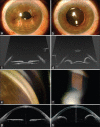Single-pass four-throw pupilloplasty for angle-closure glaucoma
- PMID: 29283136
- PMCID: PMC5778544
- DOI: 10.4103/ijo.IJO_559_17
Single-pass four-throw pupilloplasty for angle-closure glaucoma
Abstract
Angle-closure glaucoma is characterized by appositional or synechial closure of the anterior chamber angle with glaucomatous field defects that may or may not be associated with a pupillary block. Surgical pupilloplasty with single-pass four-throw technique helps to alleviate the appositional closure along with the breakage of peripheral anterior synechia, thereby increasing the aqueous outflow and decreasing intraocular pressure.
Conflict of interest statement
There are no conflicts of interest.
Figures





References
-
- Primary vs. Secondary Angle Closure Glaucoma. American Academy of Ophthalmology. [Last accessed on 2017 Aug 25]. Available from: http://www.eyewiki.aao.org/Primary_vs._Secondary_Angle_Closure_Glaucoma .
-
- Narang P, Agarwal A. Single-pass four-throw technique for pupilloplasty. Eur J Ophthalmol. 2017;27:506–8. - PubMed
-
- Luo M, Liang N. A report of pupilloplasty for secondary glaucoma after vitrectomy associated with ocular trauma. Eye Sci. 2012;27:109–12. - PubMed
-
- Shah M, Law G, Ahmed II. Glaucoma and cataract surgery: Two roads merging into one. Curr Opin Ophthalmol. 2016;27:51–7. - PubMed
-
- He M, Friedman DS, Ge J, Huang W, Jin C, Cai X, et al. Laser peripheral iridotomy in eyes with narrow drainage angles: Ultrasound biomicroscopy outcomes. The Liwan eye study. Ophthalmology. 2007;114:1513–9. - PubMed
Publication types
MeSH terms
LinkOut - more resources
Full Text Sources
Other Literature Sources
Medical

